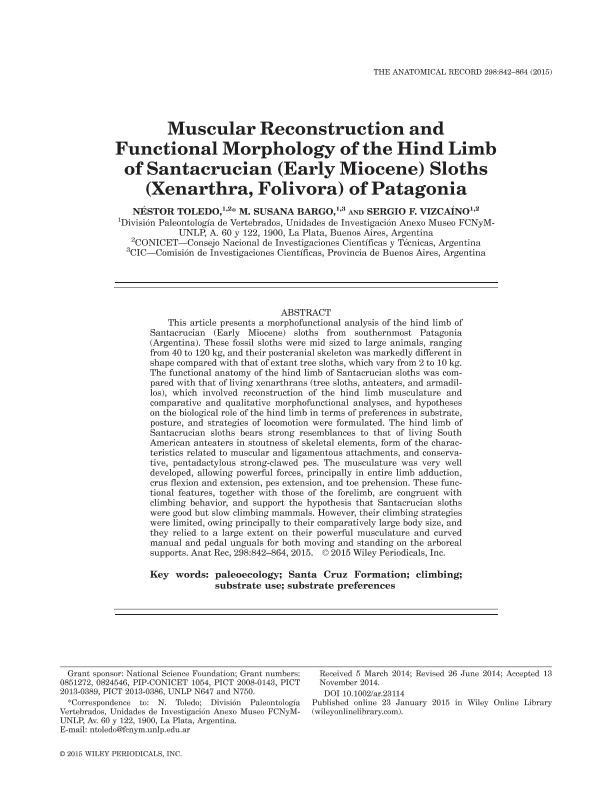Artículo
Muscular reconstruction and functional morphology of the hind limb of santacrucian (Early Miocene) sloths (Xenarthra, Folivora) of Patagonia
Fecha de publicación:
05/2015
Editorial:
Wiley-liss, div John Wiley & Sons Inc.
Revista:
Anatomical Record-Advances in Integrative Anatomy and Evolutionary Biology
ISSN:
1932-8486
Idioma:
Inglés
Tipo de recurso:
Artículo publicado
Clasificación temática:
Resumen
This article presents a morphofunctional analysis of the hind limb of Santacrucian (Early Miocene) sloths from southernmost Patagonia (Argentina). These fossil sloths were mid sized to large animals, ranging from 40 to 120 kg, and their postcranial skeleton was markedly different in shape compared with that of extant tree sloths, which vary from 2 to 10 kg. The functional anatomy of the hind limb of Santacrucian sloths was compared with that of living xenarthrans (tree sloths, anteaters, and armadillos), which involved reconstruction of the hind limb musculature and comparative and qualitative morphofunctional analyses, and hypotheses on the biological role of the hind limb in terms of preferences in substrate, posture, and strategies of locomotion were formulated. The hind limb of Santacrucian sloths bears strong resemblances to that of living South American anteaters in stoutness of skeletal elements, form of the characteristics related to muscular and ligamentous attachments, and conservative, pentadactylous strong-clawed pes. The musculature was very well developed, allowing powerful forces, principally in entire limb adduction, crus flexion and extension, pes extension, and toe prehension. These functional features, together with those of the forelimb, are congruent with climbing behavior, and support the hypothesis that Santacrucian sloths were good but slow climbing mammals. However, their climbing strategies were limited, owing principally to their comparatively large body size, and they relied to a large extent on their powerful musculature and curved manual and pedal unguals for both moving and standing on the arboreal supports.
Archivos asociados
Licencia
Identificadores
Colecciones
Articulos(CCT - LA PLATA)
Articulos de CTRO.CIENTIFICO TECNOL.CONICET - LA PLATA
Articulos de CTRO.CIENTIFICO TECNOL.CONICET - LA PLATA
Citación
Toledo, Néstor; Bargo, María Susana; Vizcaíno, Sergio Fabián; Muscular reconstruction and functional morphology of the hind limb of santacrucian (Early Miocene) sloths (Xenarthra, Folivora) of Patagonia; Wiley-liss, div John Wiley & Sons Inc.; Anatomical Record-Advances in Integrative Anatomy and Evolutionary Biology; 298; 5; 5-2015; 842-864
Compartir
Altmétricas




